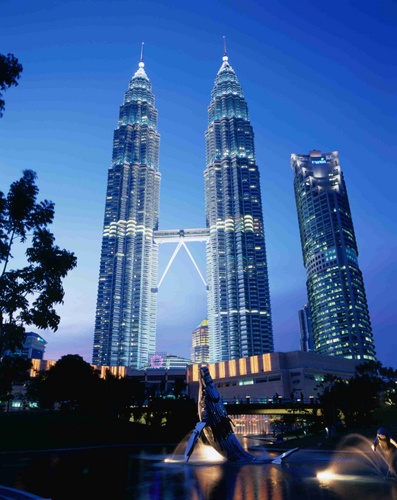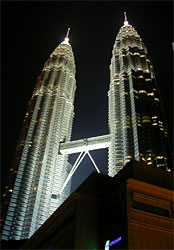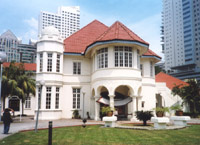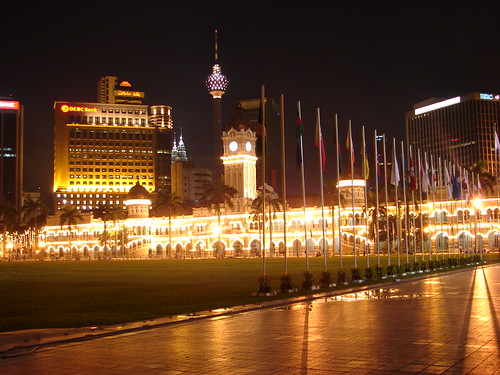Kuala Lumpur, the capital of Malaysia, is located on the west coast of Peninsula of Malaysia. Covering some 243 sq km, it lies approximately 40 km from the coast. Kuala Lumpur -or KL as it is commonly called- lies in a valley surrounded by jagged hills. Kuala Lumpur was originally a mining settlement in the late 1800s where tin was discovered at the confluence of the Klang and Gombak rivers. Although KL's tin trade has declined since, the prosperity of the city has continued to grow.  
Today, KL is home to 1.5 million people within the city proper, and more than 6 million in the surrounding metropolitan area. It is the political and cultural centre of the nation. Kuala Lumpur leads Malaysia's fast paced development in trade and commerce, banking and finance, manufacturing, transportation, information technology and tourism. Malaysia is considered one of the fastest growing country in South-East Asia. 
Kuala Lumpur has plenty to offer in terms of sights and shopping. Not to be missed is the Petronas Twin Towers at the heart of the city, one of the modern marvels of the world. The Towers are called Menara (Malay for "tower") 1 and 2, and until October 2003, they were the tallest buildings in the world. History of Kuala Lumpur Kuala Lumpur has its origins in the 1850s, when the Malay Chief of Klang sent some Chinese upriver to open new and larger tin mines. They landed at the confluence of Sungai Gombak (previously known as Sungai Lumpur, which means muddy river) and Sungai Klang (Klang river) to open mines at Ampang. Later, tin mines were opened at Pudu and Batu. This trading post was a wild frontier town plagued by floods, fires, disease and the Selangor Civil War. During this time, Kapitan Cina Yap Ah Loy emerged as a leader, responsible for the survival and growth of the town. In 1880, the state capital of Selangor was moved from Klang to the more strategically advantageous Kuala Lumpur. After the fire and subsequent flood of 1881 destroyed the town's structures of wood and atap (thatch), Frank Swettenham, the British Resident of Selangor, required that buildings be constructed of brick and tile. A railway increased accessibility. Development intensified in the 1890s, leading to the creation of a Sanitary Board. In 1896, Kuala Lumpur was chosen as the capital of the newly formed Federated Malay States. A multiracial community settled in various sections of town. The Chinese congregated around the commercial centre of Market Square, east of Sungai Klang, and south into Chinatown. To the north, across Java Street (now Jalan Tun Perak) were the Malays. Nearby, a number of Indian Chettiars (money-lenders), and in later years Indian Muslim traders, set up business. West of the river, the Padang (now Merdeka Square) was the focal point of the British administration. Kuala Lumpur grew through two world wars, the rubber and tin commodity crash and the State of Emergency, during which Malaya was preoccupied with the communist insurgency. In 1957, the Federation of Malaya gained its independence from British rule. Kuala Lumpur remained the capital through the formation of Malaysia, achieving city status in 1972, and was established as the Federal Territory in 1974. Places of Interest
 At a dizzying height of 452 metres, Petronas Twin Towers, a pair of 88-storey buildings, are the world's tallest free-standing towers. Apart from offices, these awesome towers also house a state-of-the-art concert hall--the Petronas Philharmonic Hall, home of the Malaysian Philharmonic Orchestra and the Petronas Performing Arts Group. The designs on the towers are based on geometric patterns common in Islamic architecture. Special features of the towers include the double-deck sky-bridge and high speed double-deck lifts. The first few floors house shopping arcades restaurants, a science museum and the concert hall and are the only floors open to public. Admission is free, however tickets are limited and issued daily on a first-come-first-served basis. Open Hours: T-Su 9a-5p; Skybridge closed for Friday Prayer from 1p-2:30p; Closed Monday except on a Public Holiday. Sunway Lagoon Theme Park
 Situated 20 minutes from Kuala Lumpur is Malaysia's first international-standard water theme park. Within the 80 acres of the park are water-based attractions, such as giant waterslides, twin speed slides, a river, a waterfall garden and a lagoon express. There is a shopping mall known as the Pyramid, which adds to the limitless range of activities at this theme park. There is also the charming Sunway Lagoon Resort Hotel nearby. Admission: Adult MYR35, children (3-12yrs) MYR20, children under three free), seniors (55yrs above) MYR23, price includes access to all parks. Sultan Salahuddin Abdul Aziz Shah Mosque
 One of the largest mosques in South-east Asia, this impressive building is frequently referred to as "the blue mosque." It is huge and magnificent--with an enormous, dark blue dome and four minarets standing at 142.3 metres. Decorative Islamic calligraphy enhances the dome and main prayer-hall, while the overall architecture integrates ethnic Malay design elements. The mosque is adjoined by a small lake, which makes it a particularly serene setting, especially at sunset. Visitors should dress according to the Islamic dress code. Suitable attire is provided at the main entrance. Kuala Lumpur Tower (Menara Kuala Lumpur)
 Statuesque at a height of 421 metres, the imposing tower is reputed to be the highest in Asia and the fourth tallest telecommunications tower in the world. One of the distinctive architectural features of Menara Kuala Lumpur is a dome-shaped arch at every doorway on the upper ground floor, decorated with glass pieces that illuminate like giant diamonds. Visitors can enjoy a bird's eye view of the city from either the height of the observation deck or from the revolving restaurant. Check website for full details. Property Information by Wcities Batu Caves
 This is one of the holiest Hindu shrines in Malaysia and a popular tourist attraction. The Caves are popular not only for being the southern-most limestone outcrop in the Northern Hemisphere, but the labyrinth that makes up the Batu Caves also supports a variety of exotic wildlife. There is a 272-step concrete staircase leading to the temple cave. The main cave holds a shrine of Lord Subramaniam, a Hindu deity. A cave gallery is located at the foot of the caves featuring clay figurines and wall paintings depicting scenes and figures from Hindu mythology. Petrosains
 Located within the imposing Petronas Twin Towers building, Petrosains is a modern museum housing many exciting exhibits. Covering a total area of 100,000 square feet, this interactive science discovery centre traces the development of petroleum science and technology. Among the interesting exhibits are hi-tech presentations of a singing dinosaur and a smoking volcano. The discovery journey through forest, ocean and sky, and the simulation helicopter flight in a tropical storm is just as thrilling and engaging. Malaysia Tourism Centre
 Situated along Jalan Ampang, MATIC was once known as the Tuanku Abdul Rahman Hall. Built in 1935, it was originally the mansion of Eu Tong Seng, a wealthy planter and tin-miner. Many historical events took place in this ancient building, one of which was the installation of the country's first King. After being renovated in 1988, it now houses a one-stop information centre offering a wide range of facilities to assist tourists in planning a holiday in Malaysia. Apart from providing counter services, the complex also holds cultural performances and theatrical shows in the mini-auditorium. Petaling Street
 Also known as Chinatown, Petaling Street is one of Kuala Lumpur's most popular tourist destinations. In the evenings, a line of stalls come to live in front of the pre-war shops, offering products of every description, from fake leather goods to the obligatory "Dunhill" watches. The area attracts many locals and visitors in search of bargain items, including inexpensive dresses, shoes, fabrics and souvenirs. It transforms itself into a bustling and lively night market when part of the road is closed to traffic at about 6pm.
National Museum
 The National Museum is a palatial structure adopting the style of old Malay architecture. Its imposing entrance is flanked by murals depicting aspects of Malaysian culture and history. Inside there are exhibits on local history, culture and traditions, arts and crafts, economic activities, currency, weapons and local flora and fauna.
Outside, old locomotives, vintage cars and other relics of transport from days gone by can be found. Reconstructed Malay palaces from other parts of the country also grace the expansive grounds.
Merdeka Square
 The Dataran Merdeka was once a focal point - and cricket pitch - for the British colonial presence in Malaysia. The structures bordering the Dataran Merdeka resemble the physical environment of the colonists' native land. Situated on one corner of the square is the Selangor Club, replicating the Tudors of merry old England. It was at this square in 1957 that the Union Jack was lowered and the Malayan flag hoisted, signalling Malaysia's independence as a nation. A 100-metre flagpole, one of the tallest in the world, marks the spot. Sepang International Circuit
 The Sepang F1 International Circuit is the venue used for the Formula One Malaysian Grand Prix, A1 Grand Prix as well as the MotoGP Malaysian Grand Prix. It is also used as a venue for many other major motorsport events. Widely regarded as a benchmark for other Grand Prix venues, the Sepang circuit boasts superb pit garage and media facilities, as well as impressive grandstands and patron amenities. Some complaints have been raised regarding the unevenness of the surface, as the track appears to be slowly sinking. This is possibly due to the fact that Sepang was built on the site of a former swamp. The circuit was designed by renowned German designer Hermann Tilke, who would subsequently design the impressive new facilities in Shanghai, Bahrain and Turkey. The main circuit, normally raced in a clockwise direction, is 5.54 kilometres long, and is noted for its sweeping corners and wide straights. The layout is quite unusual, with a very long back straight separated from the pit straight by just one very tight hairpin. Other configurations of the Sepang circuit can also be used. The north circuit is also raced in a clockwise direction. It is basically the first half of the main circuit. The course turns back towards the pit straight after turn 6 and is 2.71 kilometres long in total. The south circuit is the other half of the racecourse. The back straight of the main circuit becomes the pit straight when the south circuit is in use, and joins onto turn 8 of the main circuit to form a hairpin turn. Also run clockwise, this circuit is 2.61 km in length. Sepang International Circuit also features kart racing and motocross facilities. Transportation
LandKuala Lumpur has a road network leading to the rest of Peninsular Malaysia. Motorists may have a choice of paying cash, using stored value card Touch 'n Go or SmartTAG to pay at the toll booths while using the various highways/expressways. A recently-completed project, SMART Tunnel will allow motorists to enter the city, avoiding congestion by using an underground tunnel. However, despite all this, Kuala Lumpur often has traffic problems, and peak hour traffic is generally from 7:00am to 9:00am, and from 5:00pm to 9:00pm. AirKuala Lumpur is directly connected to the Kuala Lumpur International Airport (KLIA) in Sepang via the KLIA Ekspres high-speed train service which takes only 28 minutes, while travelling by car via highway will take about an hour. The former international airport, Sultan Abdul Aziz Shah Airport in Subang is now used for chartered flights. Malaysia Airlines and all major international airlines to Malaysia land at KLIA. AirAsia makes use of the newly built Low Cost Carrier Terminal (LCC-T) in Sepang. LCC-T is accessible to/from KL through a bus service from KL Sentral (transport hub). Public TransportationPublic transport on Kuala Lumpur and the rest of the Klang Valley covers a variety of transport modes such as bus, rail and taxi. Unlike most other major Asian cities, utilisation rates are low as only 16 percent of the population uses public transportation. In addition, there is the metro system consisting of 3 separate lines, which meet in the city and extend to the Western Suburbs of the state of Selangor. The metro system consists of a Monorail, an Elevated Metro, and an Automated Metro with underground stations in the city centre. Food, pets, drinks are strictly prohibited among trains and heavy penalties are charged upon violation. Commuter trains also exists to link commuters to the city. The main hub is KL Sentral facilitating as an interchange station for the main lines. Labels: Cities, Kuala Lumpur, Malaysia, Travel Guide |



wow such a great site. care to exchange links?